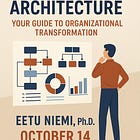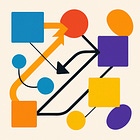Defining the Role of the Enterprise Architect
Influence without authority—but with real responsibility in modern enterprise architecture
My earlier article on how deep enterprise architects should go generated a lively discussion among practitioners.
One of the questions it raised was this: if enterprise architects shouldn’t dive too deep into business or technology, then what should they focus instead?
This article explores that question: defining the role, responsibility, and skills of the enterprise architect.
Enterprise architecture (EA) is a discipline with intentionally fuzzy boundaries. It lives between strategy and execution, business and technology, planning and delivery.
And that’s exactly why the role is so difficult to define, and so often misunderstood. Sometimes it’s mystified as all-knowing, sometimes trivialized as “drawing boxes.”
In reality, it’s neither. Enterprise architects are not the decision makers, but they make better decisions possible.
Facilitator, Navigator—and Architect
At its core, the enterprise architect’s job is to keep the EA operating model running smoothly. The job is not about authority, it’s about orchestration. It should make sure that the architecture process and deliverables actually work in practice.
That means ensuring that:
High-level architectural descriptions (like capability maps, application landscapes, and data flows) are co-created with stakeholders and kept alive.
Those descriptions are used in decision-making, not just stored in repositories.
Strategic plans, governance discussions and project reviews are informed by architecture, not detached from it.
Dependencies, risks, and consequences are made visible early, when they can still be influenced.
An enterprise architect is not a “mini-CEO” or a shadow CIO. Nor are they a technical solution architect configuring platforms or designing APIs.
Instead, think of them as a Scrum Master for enterprise architecture: someone who doesn’t do the work for others, but makes the process visible, structured, and aligned.
Whether the EA function is one person or a team of specialists, the core idea is the same: bring out the architectural perspective.
Decisions and Influence: What Is the Enterprise Architect Really Accountable For?
A common question about enterprise architects is this:
If enterprise architects don’t decide what applications to buy, what projects to start, or how strategies are executed—what are they actually responsible for? Are they accountable if the organization fails to reach its goals? Or if an ERP implementation goes off the rails?
The short answer: no. But they are accountable for ensuring that those decisions are made with the best possible understanding of their architectural consequences.
EA is about enabling good decisions, not making them all. Strategy, priorities, investments, and solutions belong to leaders, steering groups, and delivery teams. The enterprise architect’s role is to prepare the ground. To document options, surface dependencies, highlight risks, and frame alternatives so decision-makers clearly see what’s at stake.
In other words, the architect isn’t responsible for what the organization decides, but for how it decides.
That means ensuring EA content is explicit, transparent, and actually used when choices are made. When that happens, even imperfect decisions are easier to manage, because their consequences are visible and deliberate. And, when something goes against the architecture, it’s a conscious choice rather than an accident.
This also distinguishes enterprise architects from other architects. A solution architect may be accountable for whether a specific system design works. But the enterprise architect’s responsibility is to make sure such designs are made on a sound architectural foundation.
They don’t guarantee success, but they help make success possible. Their influence comes not from authority, but from clarity: helping others make better decisions, faster, with fewer surprises, and with a shared understanding of the bigger picture.
When the Enterprise Architect Isn’t Heard
Of course, influence only works if it’s actually accepted.
Even the best enterprise architect can’t steer decisions if their input is ignored, or if EA is treated as a checkbox at the end of the process. When that happens, responsibility ends where influence does.
An architect can prepare the facts, clarify options, and highlight risks—but they can’t force others to listen, and they can’t own decisions others refuse to base on it. In those cases, EA isn’t failing as a discipline; the organization is failing to use it properly.
That said, sometimes the silence is partly on the architect, too. If they speak in a language no one understands, show up too late in the process, or focus on abstract models instead of real business concerns, it’s no wonder the message doesn’t land.
Influence isn’t granted. It’s earned, through relevance, timing, and trust.
That’s why these matter just as much as technical skill. EA earns its seat at the table by consistently bringing added value to decision-making.
Skills That Matter
Ask a dozen enterprise architects what skills the role requires, and you’ll likely get a list that sounds almost superhuman—strategy, business, technology, governance, communication, modeling, leadership, negotiation, and more.
And yet, the best enterprise architects rarely meet that mythical checklist. Instead, they master a few key abilities that make them effective in the real world.
At the same time, frameworks, tools, and technical skills often get more attention than they deserve. Knowing TOGAF, ArchiMate, or a specific software tool inside out doesn’t make you an effective architect. Using them to bring clarity and structure to decisions does.
Being a good enterprise architect isn’t about knowing everything. It’s about being able to connect anything.
Here’s what that looks like in practice:
Communication. Explaining complex structures in clear, grounded language, so that non-architects can actually understand and use the insight.
Facilitation. Bringing people together to see dependencies, surface risks, and make trade-offs consciously. The architect often achieves more with a whiteboard than a mandate.
Analysis and synthesis. Making sense of complexity by finding structure in the chaos. Connecting the dots between strategies, activities, applications, data, and people.
Modeling and visualization. Capturing the architecture so that others can see it—using fit-for-purpose frameworks, notations (like ArchiMate), and tools to make structures, dependencies, and impacts tangible.
Will and capability to learn. Diving into new topics—from cybersecurity to supply chains—just far enough to understand their implications for the bigger picture.
Persistence. Keeping architecture relevant when leaders are focused on urgent priorities and when silos resist alignment.
Service mindset. Remembering that the job is not just to create deliverables, but to help others make better decisions.
Enterprise architects don’t need to know more about business than the CEO, more about data than the analysts, or more about technology than the solution architects. They just need to know enough of each to build the bridge between them, and the confidence to keep people walking across it. (More about this in an earlier article.)
Final Thoughts
So, what kind of person is the enterprise architect?
A facilitator, not a dictator.
Accountable for making architecture visible and usable, not for making every decision or bearing their consequences.
Skilled at bridging business, data, and technology without trying to out-expert the experts.
Persistent, communicative, and service-oriented—helping the organization steer change with confidence.
The enterprise architect doesn’t have all the answers—but makes sure the right questions are asked, explored through dialogue, and genuinely considered in decision-making.
They also don’t own every decision. But when they do their job well, every major decision bears their influence. That’s how architecture quietly shapes transformation.
And if you were hoping for a comfortable role without real responsibility—this isn’t it. It’s demanding, complex, and sometimes frustrating. But when it works, it’s also one of the most rewarding ways to help an organization truly move forward.
📢 Upcoming Book Launch Events
My new book Enterprise Architecture – Your Guide to Organizational Transformation (Business Expert Press) will be published on October 14.
To celebrate, I’ll host two short virtual launch sessions:
English session: Thursday, October 30 (17.00–17.45 EET / 16.00 CET / 11:00 AM EDT / 8:00 AM PDT) – an introduction to the book, short practical talk on how enterprise architecture helps organizations manage transformation, and Q&A.
Register here: Teams Webinar
Finnish session: Wednesday, October 22 (16.00 EEST) – an introduction to the book, a practical discussion on why enterprise architecture matters beyond IT, and Q&A.
Register here: Teams Webinar
Both events are free and open to everyone. See you there!
🔗 You May Also Like
Looking to dive deeper? Here are more enterprise architecture insights you might find useful:
📬 Want More Practical Enterprise Architecture Content?
Subscribe to Enterprise Architecture Transformation for real-world advice on architecture that supports change, strategy, and delivery.





